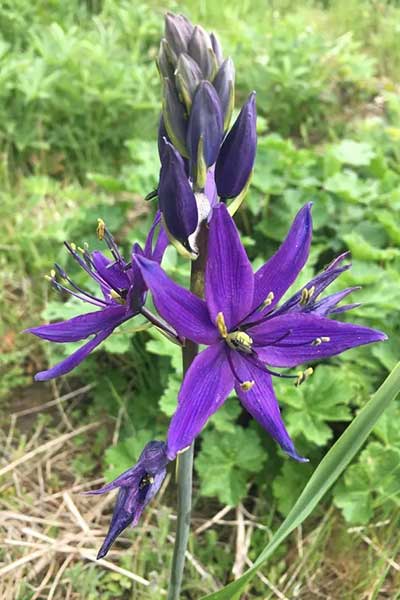Great Camas
- Scientific Name: Camassia leichtlinii
- Garden: Rain Garden
- Plant Type: Herbaceous Perennial
- Evergreen/Deciduous: Deciduous
- Sun/Shade Exposure: Full Sun to Part Shade
- Moisture Requirements: Dry
Plant Information
Great Camas is the larger and some say showier cousin to common Camas (Cammasia quamash ssp. maxima). Its found throughout the western valleys of the state. Rising to 2′ tall in mid spring the petals of great Camas are not only larger they are stiffer as well. The large star shaped flowers open from the base to the top. They range greatly in color from pale blue to the most common dark blue. Its a luminous color that beckons pollinators. Small black hover flies gather on the flowers to collect pollen. Forms increasing colonies in rich soil that retains moisture. Its often seen in winter wet areas, but it can be found under oaks and firs in woodlands as well. It grows and blooms simultaneously with its common associates, Sidalcea malviflora ssp. virgata and occasionally even with Iris tenax (Oregon Iris). Its most striking neighbors in the wild are wild Parsnip (Hieracleum maximum) as well as Ranunculus occidentalis (Western Buttercup). Leaves precede the flowers and the whole plant goes cleanly summer dormant after seed set. Very adapted to heavy soils. No supplemental irrigation is required once established. In the wild it is found from full sun to quite a bit of shade on the verge of woodlands. Oregon native plant.
Plant type: Herbaceous perennial
Sun exposure: Full Sun, Part Shade
Biome: Low Water/No Water, Oregon Coast, Western Native, Willamette Valley Natives
USDA Hardiness zone: Zn5b -10º to -15ºF
Foliage color: Dark Green
Foliage season: Winter Deciduous
Data Source
https://www.xeraplants.comPlant Photos



